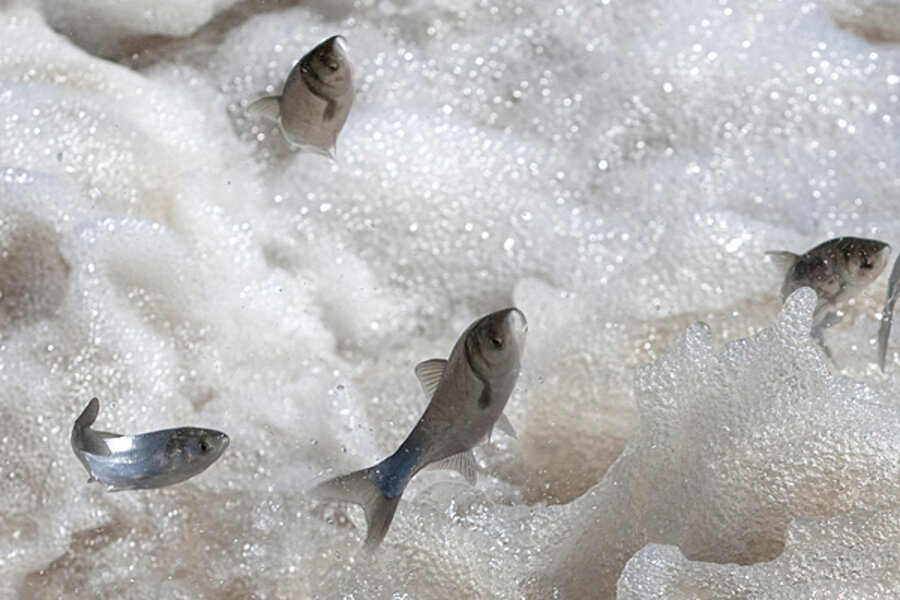Asian carp: multiple efforts afoot to find a Great Lakes solution
Loading...
| Chicago
Concerns about Asian carp potentially infiltrating the Great Lakes have led to plenty of acrimony. Much of the discord has centered on two shipping locks in the Chicago area through which the fish might migrate. While five Great Lakes states want the locks closed down permanently, Illinois has so far refused.
The two sides recently took up the locks issue in federal court, arguing about how imminent an invasion is, the impact of a locks closure on the cargo shipping industry, and the potential effect of Asian carp on the lakes’ recreational and commercial fishing industry.
But with that much at stake, US officials are also looking for alternative, less acrimonious ways to address the Asian carp situation. These efforts may not be disagreement-free, but they’re attempts to arrive at solutions.
Some federal efforts were highlighted at a meeting in Washington on Wednesday between White House officials and representatives from Great Lakes states. The attendees discussed progress made since February on the construction of a third electric barrier, which is set for completion next month.
They also received updates on a $13.2 million project by the US Army Corps of Engineers to build a concrete and chain-link fence between the Chicago Sanitary canal and the Des Plaines River. An additional effort discussed: the removal, which began in May, of about 104,000 pounds of Asian carp from a stretch of the Illinois River located further downstate.
The federal effort is also aiming to develop biological controls, such as poisons designed to work specifically on Asian carp to reduce their populations. Another goal is a stronger electric and physical barrier system.
Two governors attended the meeting – Michigan’s Jennifer Granholm (D) and Ohio’s Ted Strickland (D) – along with officials from Illinois, Indiana, New York, Minnesota, and Wisconsin.
Last week, the Obama administration responded to criticism that its efforts lack urgency with the announcement that John Goss, the former head of the Indiana Department of Natural Resources, would be the Asian carp director. This is a new position, and Mr. Goss will now direct the $78.5 million effort to combat carp migration.
On Wednesday, Governor Granholm issued a statement that reiterated the call to close the navigational locks and pressed Goss to “bring to this position the sense of urgency required to strengthen and expedite the federal response.”
Meanwhile, in Chicago, Mayor Richard M. Daley has proposed the possibility of reversing the flow of the Chicago River, which was reengineered almost 100 years ago to divert untreated sewage away from Lake Michigan.
“That could be the salvation, maybe, to the Great Lakes,” he told the Chicago Tribune last week.
Sen. Richard Durbin (D) of Illinois and Sen. Debbie Stabenow (D) of Michigan are drafting a bill that would force the US Army Corps to study how much it would cost to reverse the river’s flow.
But last week in federal court in Chicago, the central issue was the potential closure of the two locks – in the Chicago River and Calumet-Sag Channel. US District Judge Robert Dow held three days of hearings that explored arguments from Illinois and from five opposing states – Michigan, Minnesota, Ohio, Pennsylvania, and Wisconsin.
Both sides presented testimony from experts who used data to support their respective cases. University of Notre Dame biologist David Lodge testified that carp DNA found east of the electric barrier in Chicago proved that at least a handful of fish were within ready access of Lake Michigan. His lab results, he said, located the carp at several spots along the canal system. Mr. Lodge described the Great Lakes as being at “a very imminent risk of invasion” that he said would be “irreversible.”
Competing testimony supported the fish-migration theory but maintained its effects would be largely minimal and may not appear for decades. In this argument, Asian carp would find it difficult to sustain a significant population in the Great Lakes because of fluctuations in water temperature, food shortages, and strength of the current.
Duane Chapman, a biologist with the US Geological Survey, testified that not enough is known about the Asian carp to support an immediate closure, describing its behavior as “cryptic.” “I do believe individual [fish] will survive, but a large population? It’s hard to say.... We don’t know what will happen, but we can make some guesses,” Mr. Chapman said.
Judge Dow said he would reach a verdict sometime in the late fall.
Environmentalists, perhaps not surprisingly, are in favor of taking action sooner rather than later.
“We do not want to run a real-time experiment,” says Jennifer Nalbone, director of navigation and invasive species for Great Lakes United, an environmental advocacy group in Amherst, N.Y. The unknown factors are not compelling enough to prevent emergency measures from being enacted now, said Ms. Nalbone in a phone interview Thursday.
“Just because we can’t tell what kind of bad this should be doesn’t mean we should pause in trying to solve this problem,” she says.





